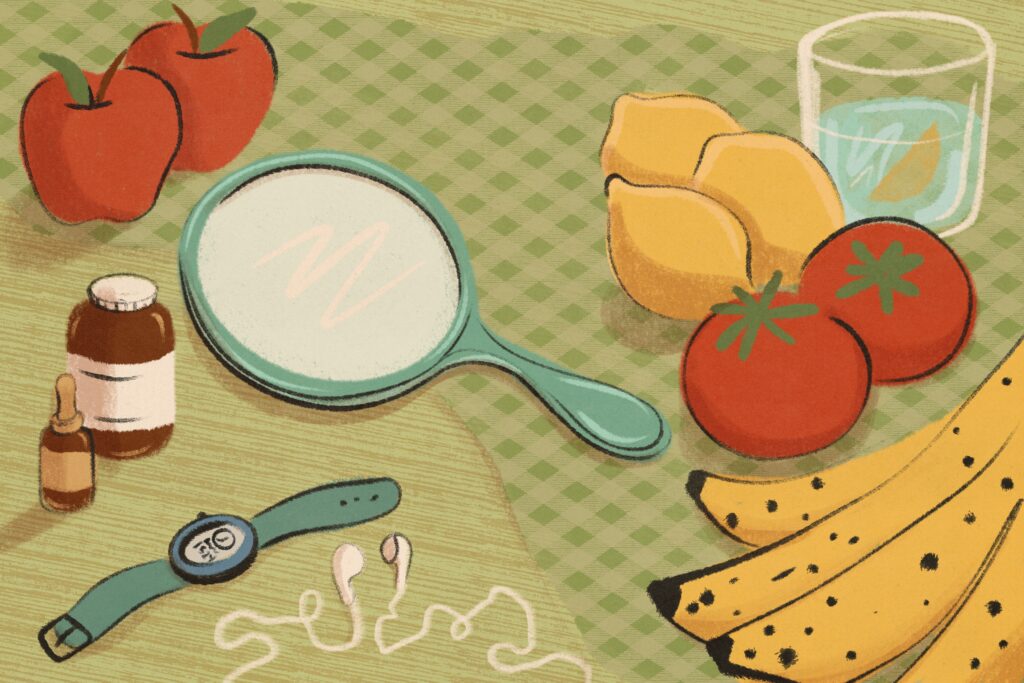Holly Mann remembers a time — it must have been twelve years ago — when she started feeling old. Then 27, the US Army veteran found that she could no longer comfortably exercise. She was sapped of energy, and carried pain in her shoulders, hip, knees, and wrists. “I had a lot of issues that I would frankly associate with somebody who was two decades older than me,” she says. The doctors said that her symptoms stemmed from months of undetected carbon monoxide poisoning. They couldn’t tell her any more than that. Ms. Mann was desperate to feel better — really, she says, to feel younger.
Consulting the internet, she started tinkering with her diet. She tried new workouts. She ordered capsules of Vitamin This and Supplement That. And a few years in, after incremental ups and downs, she started to see real improvements. Though she still faced her share of low-energy days, by 2020, Mann felt noticeably better. She was curious: how much better? Had she, possibly, turned back the hands of time?
This raised her interest in “DNA methylation clocks,” algorithms that search for aging patterns in our blood. “Methylation clocks can tell the difference between young and old,” says Rozalyn Anderson, a gerontologist with the University of Wisconsin Madison’s School of Medicine and Public Health. “They are absolutely capturing something that happens with age, and they’re capturing it very well.” While primarily a research tool, a growing number of companies now offer versions of these to the general public as at-home blood tests. Holly Mann ended up ordering a kit called myDNAge, a mail-in test that asks users for a little blood, then sequences their DNA sample, and returns a report revealing their true biological age. The test is a hit among a growing subculture of people experimenting with rejuvenation. Their questions are both practical and metaphysical: How old am I really? Am I in control of my age?
For the anti-aging community, this new class of products opens up a whole host of semantic, methodological, and scientific questions. Considered in depth, they delineate the possibilities of anti-aging technology — but also its limitations.
Clocking Epigenetic Changes
Methylation describes tiny bits of carbon that glom onto C’s of your AGTC genetic alphabet. Its presence or absence can control how genes contribute to a body’s function. Based on your lifestyle choices — whether you, for example, smoke or eat unhealthy food — these changes accumulate. Decade over decade, your DNA lugs these carbon bits around like biological baggage. In sum, these subtle transformations reflect the gradual onslaught of aging.
They offer more than a diagnosis; they present a challenge.
Experts argue that accumulating DNA methylation (or demethylation) over a person’s life says more about their susceptibility to age-linked disease than the number of candles on their last birthday cake. And some companies even suggest that they can reverse this process. AgelessRX, for example, sells dietary supplements and battery-powered patches that claim to reverse methylation changes to lower your biological age. The promise of this technology is an intoxicating one, and this new industry raised $589 million in funding in 2021 alone.
These companies are catering to a new thriving subculture of anti-aging enthusiasts that find each other in forums like Reddit’s r/Longevity. This is how Holly Mann, by then an internet marketer, found MyDNAge. She remembers awaiting the results nervously. “My heart started racing a little. I said a little prayer like ‘Please God, don’t let it be bad.’” She was 37 when she took the test. The report said her biological age was 34. She felt emboldened to continue experimenting. By her next go at it, Mann wanted her “age” to fall to 32. This is a key aspect of this new subculture, where epigenetic clocks are treated like fitness trackers. They offer more than a diagnosis; they present a challenge.
Surrogate Metrics
An early version of the epigenetic clock emerged from a UCLA lab in 2011. Scientists recruited 34 pairs of identical twins and found methylation patterns in around 80 genes. Some spots along DNA consistently pick up extra carbon during aging, and some shed it. By reading those patterns on others, they could reliably predict a person’s age, give-or-take five years.
In 2013, UCLA professor Steve Horvath doubled down with a clock based on more people and methylation patterns from more genes — 353 epigenomic sites in total. It provided stronger evidence that DNA methylation correlates with aging. Horvath was busy chasing a surrogate metric for aging. His clock was licensed by UCLA to myDNAge.
“The exciting thing is that we know these clocks are reversible,” Horvath, now a principal investigator at Altos Labs, a cellular rejuvenation startup, says. The question that remains is a profound one: how? What precise set of steps might allow someone like Mann to reduce their epigenetic age? And would that delay the final inevitable outcome?

What actually works?
It’s hard to get many scientists from the aging world to agree on more than broccoli, daily walks, and simply eating less. In a recent clinical trial, researchers studying calorie restriction noticed a dumbfounding change in a small organ called the thymus. The thymus sits above the heart and pumps out new immune cells. It degrades gradually with age, starting around 25. Active cells get replaced by fat, and a once steady stream of new immune cells dries up by 50 until it is only a fraction as active.
Restricting calories reversed that aging-associated decline. Trial participants, who consumed 14 percent fewer calories for two years, left with “rejuvenated” thymuses, says Vishwa Deep Dixit, who led the study and directs the Yale Center for Research on Aging. The results stunned him: “We never actually thought that this was even possible.” Participants also left with reduced chronic inflammation.
The trial isn’t meant to be lifestyle advice, though. (Even Dixit isn’t changing his habits: “Absolutely not,” he says. “. I love what I eat. Life is too short.”) Instead, it brings into focus how the entire body — and cells — might change when aging slows.
Maybe your heart ages faster than the rest of you.
Although it’s unclear precisely what’s going on at the cellular level, researchers do agree that boosting immunity and cutting inflammation are solid bets for living longer. Chronic inflammation is associated with age-related diseases like diabetes, cancer, and dementia. The signs of inflammation or susceptibility to disease may in fact appear within the epigenome, as well. In blood cancers, for example, the most frequently mutated genes are the ones that direct epigenetic changes. Methylation plays a role in regenerative processes for damage such as glaucoma. In 2020, scientists reversed methylation in the retinal cells of old mice. Those mice’s optical nerves regenerated, and it restored their vision.
These straightforward examples are rare, though. By and large, simply knowing about this link in no way implies an ability to reverse it. That’s true for cancer, and aging in general, according to Jennifer Trowbridge, a biologist at The Jackson Laboratory who studies both: “The jury is very much out.”
This key distinction — between correlation and causation — is what gives Trowbridge pause about epigenetic clocks. Researchers haven’t learned enough to diagnose problems based on methylation, or prescribe reliable solutions.
“It’s great to have a biomarker to say, ‘Hey there’s an issue,’” she says. “But that doesn’t necessarily mean that changing that epigenetic marker with some kind of intervention will result in a healthier and longer life.”
“I still think that they are really the best we have at the moment,” Sara Hägg, an epidemiologist studying aging at Sweden’s Karolinska Institute, says of epigenetic clocks. In 2017, she published a scientific review comparing methylation to five other methods of predicting age, such as measuring proteins that circulate in blood. Epigenetic clocks came out on top. They made the strongest predictions and were relatively well-vetted. That doesn’t mean, however, that epigenetic clocks are foolproof for consumers.
Hope & Hype
“There’s a lot of great science in it. I just think it has been oversold,” says Peter Adams, co-director of aging, cancer and immuno-oncology at Sanford Burnham Prebys.
He takes issue with tendencies to summarize “biological age” as a single number. Maybe your heart ages faster than the rest of you. Maybe your thymus ages slower. A 37-year-old who tests as 34 or 44, may put too much stock in that one number. Also, researchers find methylation patterns by studying populations — the endeavor gets dicey when you start making predictions for individuals.
Horvath agrees that epigenetic aging tests aren’t ready for the clinic. “It shouldn’t be part of the annual physical,” he says. “I don’t think we’re there yet.” Still, consumers may find the data helpful for their own reasons — as long, he says, as they don’t overinterpret it.
“If it gave the person a sense of control over their own aging and what they could do, that would be a hugely positive thing,” says Anderson, University of Wisconsin gerontologist. “Everyone will die. What happens before you get there — that’s malleable.”
In the year between Ms. Mann’s first and second myDNAge test, she logged her habits religiously. She had already cut out gluten and dairy. Sugar was next. She dabbled in intermittent fasting, and cold exposure. One supplement gave her a borderline uncomfortable surge in energy. “It was almost too much energy to be honest,” she says. She switched to an alternative.
By January of 2021, she decided to test again. She was 38, chronologically speaking, and still hoping to see “32” on her report. This time, she got it. “I was very excited,” she says.
How she feels remains by far the most important metric to her. “Even if I never saw any blood test results, I’m so happy that I feel so much better than I used to,” she says. But the tests do scratch an itch. “I’m a self-experimenter. So I love doing this kind of stuff.”
When interviewed, Mann was still experimenting with anti-aging strategies and supplements. It had been over a year since she last measured her epigenetic age. Then, it struck her: “I think I have one in my basement,” she says. “I have a good feeling about this one.”



